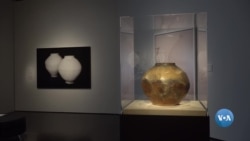ງານວາງສະແດງໃໝ່ຢູ່ທີ່ ພິພິດຕະພັນ ສີລະປະເດນເວີ້ ເຊີດຊູໄຫວົງເດືອນຕ່າງໆຂອງເກົາຫຼີ ຊຶ່ງເປັນພາຊະນະສີຂາວສະຫງ່າງາມ ທີ່ຮຸ່ງເຮືອງໃນສັດຕະວັດທີ 17 ແລະ 18 ທີ່ເປັນຄວາມຮ່ວມມືກັບພິພິດຕະພັນແຫ່ງຊາດເກົາຫຼີ ໂດຍຈັດສະແດງໂລກທີ່ຍັງຄົງລຶກລັບ ແລະງານສີລະປະທີ່ເປັນແຮງບັນດານໃຈໃຫ້ແກ່ພວກເຂົາເຫລົ່ານີ້.
ຍົງຊິນ ລີ ຜູ້ອຳນວຍການບໍລິຫານຫ້ອງການຄວາມຮ່ວມມືດ້ານການສຶກສາ ແລະ ວັດທະນາທຳທີ່ພິພິດຕະພັນແຫ່ງຊາດເກົາຫຼີ ກ່າວເປັນພາສາເກົາຫຼີວ່າ.
“ສຳລັບນັກສີລະປີນຮ່ວມສະໄໝ ໄຫວົງເດືອນເປັນແຮງບັນດານໃຈຢ່າງຫຼວງຫຼາຍເນື່ອງຈາກຄວາມລຶກລັບຂອງມັນ ພວກເຮົາບໍ່ຮູ້ວ່າ ພວກມັນຖືກໃຊ້ເຮັດຫຍັງ ຫຼືເປັນຫຍັງພວກມັນເຖິງຜະລິດອອກມາໃນຊ່ວງເວລາສັ້ນ ໆ ເຊັ່ນນີ້.”
ງານວາງສະແດງນີ້ນໍາສະເໜີເຄື່ອງປັ້ນດິນເຜົາສັດຕະວັດທີ 18 ມາປຽບທຽບກັບ ໄຫແບບດັ້ງເດີມ ໃນສັດຕະວັດທີ 21 ຊຶ່ງເຈົ້າໜ້າທີ່ຜູ້ຮັກສາຂອງ ພິພິດຕະພັນສີລະປະ ເດນເວີ້ ຮີຍອນຈອງ ຄິມ ຮັນ ( Hyonjeong Kim Han) ກ່າວສະທ້ອນເຖິງຄວາມເຊື່ອມໂຍງລະຫວ່າງອະດີດກັບປັດຈຸບັນ.
ຮີຍອນຈອງ ຄິມ ຮັນ ເຈົ້າໜ້າທີ່ຮັກສາສີລະປະເອເຊຍກ່າວວ່າ
“ ຂ້ອຍຕ້ອງການໃຫ້ຜູ້ຄົນຄົ້ນຄິດແລະຄິດເຖິງສິ່ງທີ່ເກີດຂຶ້ນໃນອະດີດລວມເຖິງສິ່ງຮອບຕົວພວກເຮົານໍາດ້ວຍ.”
ໄຫເຫຼົ່ານີ້ ຖືກແບ່ງອອກເປັນສອງສ່ວນແລະເຊື່ອມເຂົ້າດ້ວຍກັນຢ່າງບໍ່ສົມບູນ
ຈິດຕະກອນ ຢາງຈຸນ ພີ ລີວ (YoungJune P. Lew ) ກ່າວວ່າ ຄວາມບໍ່ສົມບູນແບບຂອງໄຫວົງເດືອນ ຄືສະເໜ່ດຶງດູດ.
(YoungJune P. Lew, ຈິດຕະກອນຍິງກ່າວເປັນພາສາເກົາຫຼີວ່າ
“ ສຳລັບຂ້ອຍແລ້ວ ການບໍ່ສົມດຸນນັ້ນ ສົມບູນແບບກວ່າ ເພາະເມື່ອທ່ານເບິ່ງເຫັນສິ່ງຕ່າງ ໆ ໃນທຳມະຊາດ ບໍ່ແມ່ນວ່າ ທຸກຢ່າງຈະສົມດຸນ ຄວາມບໍ່ສົມບູນເຫຼົ່ານັ້ນ ເຮັດໃຫ້ມີຄວາມອິດສະລະຫຼາຍຂຶ້ນໃນການໄຫຼໄປຕາມທຳມະຊາດ ແລະສິ່ງຕ່າງ ໆ ຮອບຕົວເຮົາ.”
ໃນບັນດາຜົນງານຮ່ວມສະໄໝນີ້ ມີໄຫວົງເດືອນປະເພດ ເຣຊິນ ແລະ ໄຟເບີ້ແກລສ ຈາກນັກອອກແບບ ມິນແຈ ຄິມ (Minjae Kim) ເຂົາບອກວ່າ ຄວາມບໍ່ສົມດຸນຂອງໄຫວົງເດືອນເຮັດໃຫ້ເບິ່ງເຂົ້າເຖິງໄດ້ຫຼາຍຂຶ້ນ.
“ ມີຊັ້ນຄວາມບໍ່ສົມບູນແບບໃນຕົວທີ່ຜູ້ຄົນຊື່ນຊົມ ແລະຝຶກຝົນຫຼືຝຶກຝົນມາໃນທາງນຶ່ງບໍ່ມີຈຸດທີ່ສົມບູນແບບຫຼືສົມບູນແບບທີ່ວັດໄດ້ ຂ້ອຍຮູ້ວ່າ ຖ້າຂ້ອຍໄປໄກ ກວ່ານີ້ ທ່ານຈະພົບວ່າ ການເຊື່ອມໂຍງຫຼືສື່ສານກັບຜົນງານອັນນຶ່ງນັ້ນ ຍາກຂຶ້ນເພາະມັນສົມບູນແບບເກີນໄປ.”
LEW ບອກວ່າ ໄຫວົງເດືອນຍັງຄົງເປັນສູນກາງຂອງເອກະລັກຂອງເກົາຫຼີ ມາຮ້ອຍປີຫຼັງຈາກທີ່ມັນປະກົດຕົວຄັ້ງທຳອິດ.
ຈິດຕະກອນຍິງ ຍົງຈູນ ພີ ລີວ ກ່າວເປັນພາສາເກົາຫຼີວ່າ
“ ໄຫວົງເດືອນເປັນເຄື່ອງສະທ້ອນຈິດວິນຍານຂອງຊາວເກົາຫຼີ ມັນບັນຈຸຄວາມຄິດ ແລະຈິດວິນຍານຂອງຜູ້ຄົນທັງໝົດໄວ້ໃນໄຫດຽວ ແລະ ນັ້ນຄືເຫດຜົນວ່າເປັນຫຍັງໄຫວົງເດືອນ ຈຶ່ງຍັງຄົງສື່ເຖິງຊາວເກົາຫຼີ ຈົນເຖິງທຸກມື້ນີ້.”
ງານວາງສະແດງນີ້ ຈັດສະແດງໄຫວົງເດືອນ 12 ໄຫ ໄຫລະນຶ່ງວົງເດືອນສຳລັບແຕ່ລະເດືອນ ໃນປະຕິທີນຈັນທະຄະຕິ ລວມເຖິງພາບແຕ້ມແລະງານສີລະປະ ໃນສື່ອື່ນ ໆ.
ອ່ານບົດລາຍງານເປັນພາສາອັງກິດ
celebrates Korean moon jars — the elegant white vessels that flourished in the 17th and 18th centuries. It’s a collaboration with the National Museum of Korea showcasing the still-mysterious globes and the art they inspire.
Yongshin Lee is executive director of the Education and Cultural Cooperation Bureau at the National Museum of Korea.
“For contemporary artists, moon jars provide a lot of inspiration because of their mystery. We don’t know what they were used for or why they were produced for such a short period.”
The show juxtaposes 18-century ceramics with 21st century takes on those traditional jars in what Denver Art Museum curator Hyonjeong Kim Han says reflects the connection between past and present.
Hyonjeong Kim Han, Curator of Asian Art
“I wanted people to reflect and meditate what happened in the past but also what’s around us.”
The jars are formed in two halves and joined imperfectly.
Painter YoungJune P. Lew says the moon jars’ imperfections are their attraction.
YoungJune P. Lew, Painterfemale in Korean
“Being asymmetrical is more perfect for me because when you see things in nature, not everything is symmetrical. Those imperfections give more freedom to flow with nature and the things around us.”
Among the contemporary works is a resin and fiberglass jar from designer Minjae Kim. He says moon jars’ asymmetries make them more relatable.
Minjae Kim, Artist
“There is this kind of built-in layer of imperfection that is admired and, in a way, trained or practiced. There’s no measurable point of completion or perfection. I know that if I go further than this, you would actually have a harder time connecting or communicating with a piece because it’s too perfect.”
Lew says moon jars remain central to Korean identity hundreds of years after they first appeared.
((YoungJune P. Lew, Painter)) ((female in Korean))
“Moon jars embody Korean spirit. It holds all these people’s thoughts and spirits in one jar. And that is why it still speaks to Koreans today.”
The show has twelve moon jars on display, one for each month of the lunar calendar, as well as paintings and artwork in other media.






ຟໍຣັມສະແດງຄວາມຄິດເຫັນ